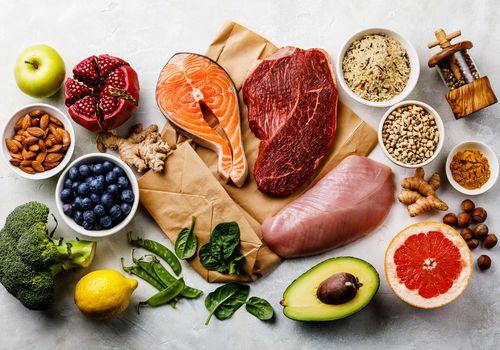What Is Nutrition and How Do You Count Macros?

How do you lose weight? How do you gain weight? What do I need to know and what are the facts? Luckily for you, this blog will have the tools, facts, and myths debunked for you, so keep reading!
Let’s dive in and go over some basics of nutrition. For starters, nutrition is more than just a “diet” because a diet is all the food that you consume throughout the day regularly. Nutrition, on the other hand refers to the fuel that your body requires to function optimally and maintain good health. Now that we know the difference, we can explore the different types of nutrients.
Your nutrients are divided into two categories macronutrients and micronutrients. Macronutrients are carbohydrates, fats, and proteins, and the micronutrients are vitamins and minerals. Macronutrients are named this way because we need these nutrients in large amounts. The same goes for our micronutrients however we only need them in smaller doses. How do you know if you’re meeting your daily needs for your macronutrients?
The way you can figure this out is by counting your macros but what does that mean? It’s simple! Your macronutrients are all worth the number of calories per one gram of food consumed. Your carbohydrates are worth 4kcal/g, proteins are worth 4 kcal/g, and fats are worth 9 kcals/g. To calculate how many nutrients are in your meal, you will perform the following calculation (food in grams/kcals of macronutrient = grams of macronutrient).
-Ex: An average chicken breast is 172g, with 80% of it being protein and 20% fat. To calculate this, you will take 80% of 172g (137.6g) and divide that number by 4 (this is the kcal/g of Protein) equaling 34.4 g of protein. For fat, you would do the same thing but instead with 20% (34.4 / 4 = 8.6 kcal/g of fat).
-Click here to use an online Marco nutrient counter!
Why is this important? It’s important because without it you are trying to gain and lose weight blindly. If not monitored could lead to serious medical issues. There is more to it than just counting your macronutrients because for these calculations to be applicable, you need to have a baseline to measure your food intake against. The baseline you are going to want to use is you Basal Metabolic Rate (BMR). The BMR is the number of calories your body burns each day without you doing anything. Meaning if you were to lie in a room all day without moving, this is the number of calories you would burn.
- To find you BMR use the Harris-Benedict Equation:
- BMR = 655 + (4.35 x your bodyweight in pounds) + (4.7 x your height in inches) – (4.7 x age)
- For example, a 200lb, 6 foot 2, 23-year-old male would do:
- 655 + (4.35 x 200) + (4.7 x 74) – (4.7 x 23) = 1764.7
- For example, a 200lb, 6 foot 2, 23-year-old male would do:
- BMR = 655 + (4.35 x your bodyweight in pounds) + (4.7 x your height in inches) – (4.7 x age)
Now that you can calculate your BMR we need to add in your activity level. To do this you multiply your daily activity level by your BMR.
- Little to no exercise: 1.2
- Light exercise a few times a week or exercise a few times a week: 1.375
- Moderate exercise 3-5 times a week: 1.55
- Heavy exercise 6-7 times per week: 1.725
-Click here to use a online BMR calculator!
If we take the same male from about and add in exercise frequency, we will get the following.
- 7 (BMR) x 1.725 (Activity Level) = 3044.108
- The ending number is the Daily Amount of Calories (DAC) you should consume in one day.
Now that we have the BMR we need to choose how we are going to break up our macronutrient intake. This is not going to be the same for everyone and it will absolutely depend on your overall goals. However, we are going to put an example so you can visually see how to do the remaining calculations. The Macronutrient split we are going to use is:
- Protein: 40%
- Carbohydrates: 40%
- Fat: 20%
Using this split we can calculate how much of each macronutrient we need to consume to meet our base level metabolic needs.
- Protein consumption is (DAC) 3044.1 * 40% / 4kcal = 304 grams
- Fat consumption in grams = (DAC) 3044.1 * 20% / 9kcal = 67 grams
- Carb consumption in grams = (DAC) 3044.1 * 40% / 4kcal = 304 grams
Cutting Weight and Bulking
With this information, we can begin to see how we are going to cut weight or bulk. To cut or lose weight, you are going to want to put yourself into a caloric deficit. This means that you are intaking fewer calories than your body needs to maintain its current state. If you are currently eating 3,000 calories, then you are going to want to drop that slightly by 200-300 calories. We suggest doing this gradually because you want this to be sustainable over a long period so you can stick with your nutrition plan and conquer your goals. A pound of fat is about ~3,500 calories and if you put yourself into a caloric deficit by 200 calories it would take roughly 17 days to lose that pound of fat. Everyone has their own goals and if you’re prepping for a show then its more natural to cut more aggressively. However, if you’re on a weight loss journey you should take a gradual and sustainable approach that can be maintained overtime.
If you’re trying to gain weight the same principle applies except that now you need to be in a caloric surplus. Sometimes eating more food is not always as easy as eating less food. When you’re bulking you need to be aware of your blood glucose levels so you do not self-induce diabetes due to the large quantities of carbohydrate intake in conjunction with your other food eaten.
To learn more visit this article for some helpful information on Cutting wight.

Leave a comment